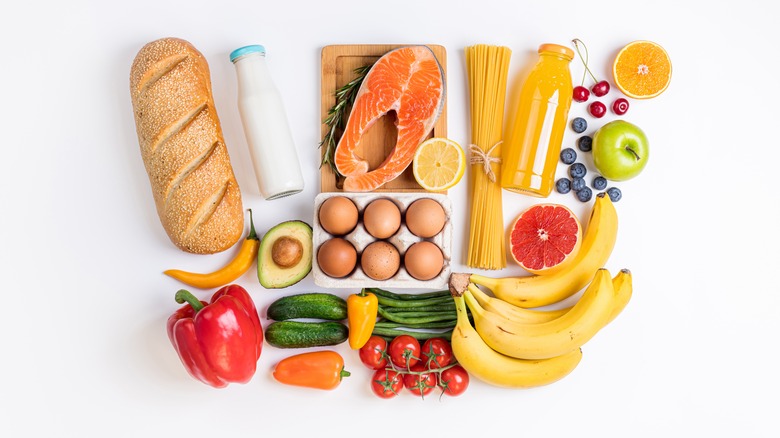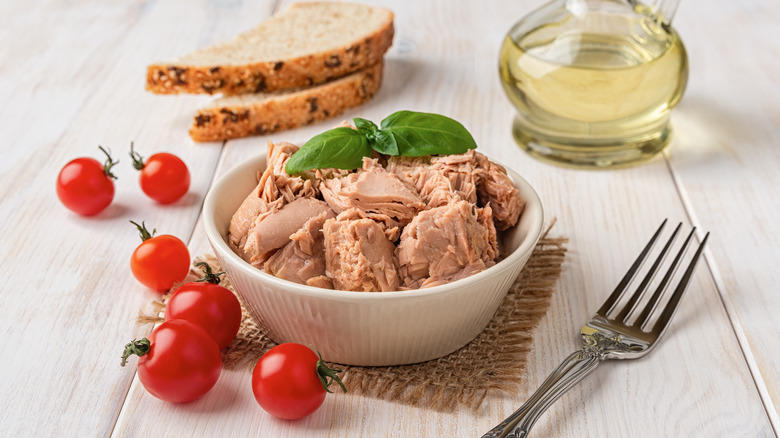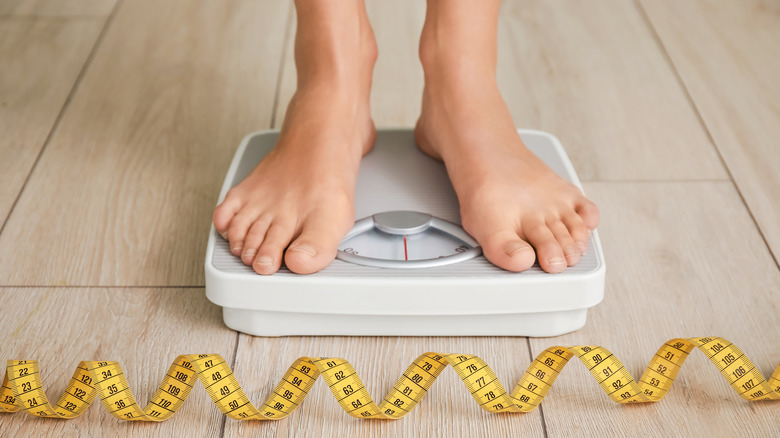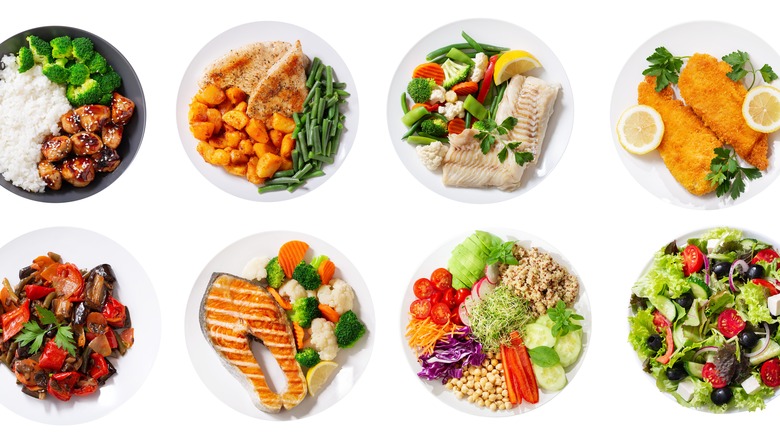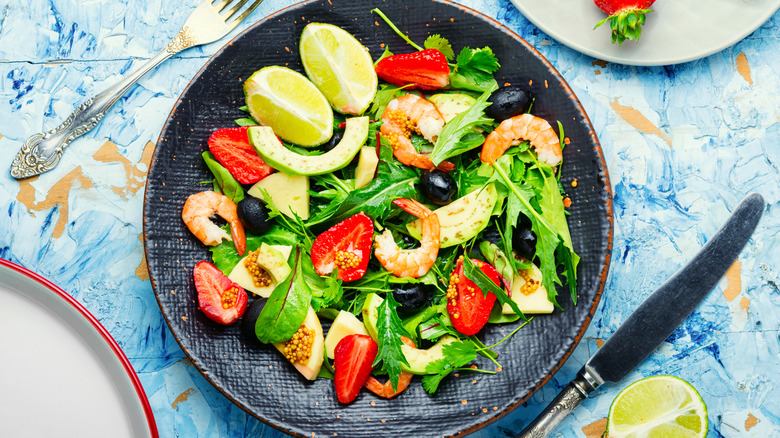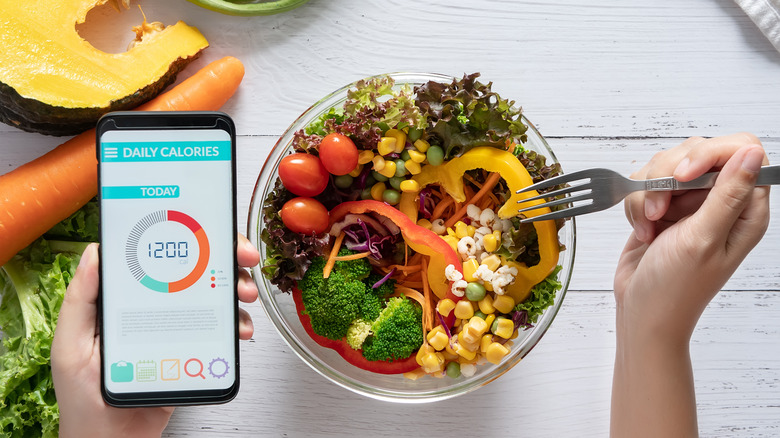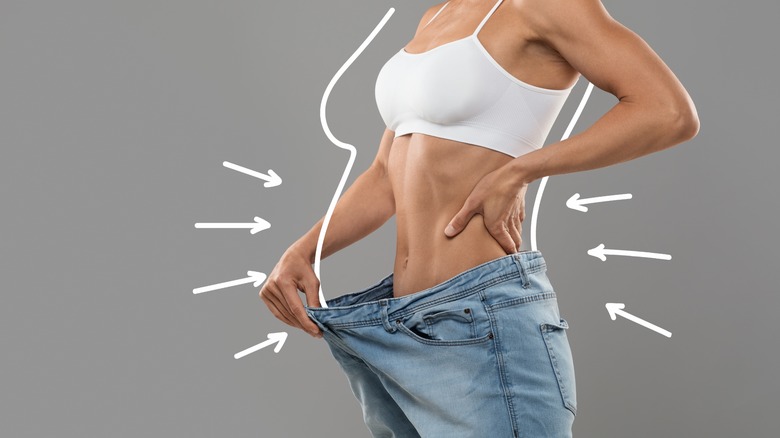Calories In Versus Calories Out: What's The Difference?
If you're trying to lose weight, you probably spend a lot of time thinking about calories: how many are in the foods you eat, how many you need to cut out of your daily diet to lose weight, whether or not you should skip that piece of chocolate cake even though it's your birthday (hint: you shouldn't).
The concept of calories in versus calories out being the key to shedding pounds has dominated the weight-loss world for decades. It's true that your calorie intake versus your calorie expenditure does matter, but it's not the whole story. Many other factors are in play, including how your body burns calories (everyone's body is different), the food you eat, your genetics and how they affect your metabolism, hormones, your body composition, and any underlying health conditions you have that affect your metabolism (via Psychology Today).
Solely using calculations of calories in versus calories out to predict weight loss typically ends in failure. Many people follow a strict diet and increase their activity level and don't lose the weight they expected. So what's the secret to real weight control or loss? There isn't a single secret, but rather a wealth of knowledge to help you make the right lifestyle choices and set realistic goals.
What are calories?
Calories are units of energy contained in food. Like gasoline for your car, your body uses the energy from calories 24/7 to power organs such as your brain, heart, and kidneys. Among all the organs, your brain uses the most energy — up to 20% (via The University of Queensland). About 10% of your calorie intake is used by the digestive system, which moves food through the digestive tract and absorbs and stores nutrients (via the Mayo Clinic). Calories are also used to fuel your daily activities of living and exercise. You're even burning calories when you're sleeping.
Each food you eat contains a specific number of calories. For example, a medium apple contains 95 calories, and a plain cheeseburger provides around 564 calories. Both the apple and the cheeseburger weigh the same amount, but the cheeseburger has significantly more calories. This has to do with macronutrient content. The three macronutrients are carbohydrates, protein, and fat. Carbs and protein each contain 4 calories per gram, while fat contains 9 calories per gram. It's important to understand that, because foods high in fat will contain more calories. This doesn't necessarily mean they're bad for you, but they will provide more energy — potentially more energy than your body needs.
Why do calories in versus calories out matter?
"Calories in" refers to the number of calories you consume. "Calories out" refers to the number of calories your body burns. Although calorie burning is quite complicated, the basic concept is that when you consume more calories than you burn, you gain weight. This is because your body stores excess calories it doesn't need for energy as fat. Your body needs a certain number of calories every day for fuel. Eating more calories than necessary one day isn't going to make a meaningful difference in your weight, but doing so over a longer period of time can lead to weight gain.
No matter what type of macronutrient you take in — protein, carbs, or fat — your body stores any of the extra energy as fat. Calories are a unit of energy; fat is a storage unit. When you create a calorie deficit over time, meaning that you take in fewer calories than you burn, your body eventually will dig into its fat stores for the energy it needs. In a vacuum, this leads to weight loss. However, it's more complicated than that.
Is calories in versus calories out a myth?
Calories in versus calories out is a matter of heated debate in the weight-loss world. The truth is that it's an outdated concept. Now that we understand more about the science of weight loss, we know that weight loss isn't that cut-and-dried. But nevertheless, the concept persists.
The general theory is that a pound of fat equals 3,500 calories. Therefore, if you burn 3,500 calories more than you consume, you can lose 1 pound. If you cut out 7,000 calories from your diet each week, you'll lose 2 pounds per week. Easy peezy.
But it's not that simple. Calorie-burning isn't a linear equation. If you decrease your calorie intake, you'll notice that in the beginning you can drop weight quite quickly. This is the rapid weight loss stage, which can last several days to several weeks, according to an article in the Journal of the Academy of Nutrition and Dietetics. After this, even if you don't change your calorie balance, weight loss will slow down and may even plateau because your body is adapting to the caloric deficit.
Other factors that affect weight loss
A major problem with the calories-in-versus-calories-out theory of weight loss is that it doesn't take into account the multitude of other factors that contribute to weight loss and weight gain. Genetic factors play a large role in body weight. For instance, research has identified genetic variations that affect hunger cues and overeating, activity level, and metabolism, according to the Centers for Disease Control and Prevention (CDC). Certain genes can influence your body's ability to use fat as fuel, or the way your body stores fat.
Hormones also play a role. Leptin, insulin, estrogens, growth hormones, and androgens are all hormones involved in metabolism, hunger cues, and the way the body stores fat (via the BetterHealth Channel). Imbalances in these hormones can lead to weight gain and obesity. In turn, having high body fat can predispose you to imbalances in these hormones that can contribute to metabolism abnormalities and challenges with losing weight.
Underlying health conditions can also influence your metabolism and your ability to lose weight, even when you reduce your calorie intake and exercise more (per Garcia Weight Loss & Aesthetic Centers). Cushing's syndrome is caused by high levels of the stress hormone cortisol. Weight gain, particularly in the upper body and face, is a symptom of Cushing's syndrome. Abnormal hormone levels can lead to the development of polycystic ovary syndrome (PCOS), a symptom of which is unexplained weight gain. Chronic inflammation, caused by environmental and dietary factors, can cause cell damage that might make it difficult to lose weight no matter what you try.
How many calories do you need?
Even though there are many other factors involved in weight loss, calories in versus calories out does still matter. Calorie-counting isn't necessary, but it's helpful to know an estimate of how many calories you need per day so you can more easily balance the calories you take in versus the calories you burn.
According to ACE fitness, three main factors contribute to your daily calorie needs: resting metabolic rate (RMR), activity level, and thermogenesis, or heat production. RMR comprises about 60-80% of daily calorie needs. RMR is the amount of energy (calories) the body uses while at rest. Physical activity level is the second most important contributor to calorie needs, but it varies greatly from person to person. A small component of your daily caloric needs is thermogenesis, which is the energy used to digest food.
Estimated calorie needs are based on your age, gender, and physical activity, according to the Dietary Guidelines for Americans. Men typically need more calories than women, and people who are active need more calories than those who are sedentary. Calorie needs decline with age. For example, a moderately active male age 31-35 needs around 2,600 calories per day, while a moderately active female in the same age group needs 2,000 calories. A 25-year-old male who is active needs 3,000 calories daily, while a sedentary male of the same age needs only 2,400 calories. And as we get older, our calorie needs change. At age 19, a woman's intake should range from 2,000-2,400, depending on activity level; at 61 years of age, her daily calorie needs have dropped to between 1,600 and 2,000.
How to burn more calories
Increasing your calories out is an important part of maintaining and losing weight. While diet is crucial, exercise not only burns calories but can also have positive effects on your metabolism.
Cardiovascular exercise, such as jogging or cycling, burns calories while you're doing it, and improves cardiorespiratory health. A general recommendation is to exercise at a moderate level for 30 minutes every day (via the Mayo Clinic). However, if you are trying to lose weight, you may need to do more exercise, or do it at a more vigorous intensity. The more vigorous your workout, the more calories you'll burn. For example, a person of average weight will burn about 198 calories doing low-impact aerobics for 30 minutes (via Harvard Health Publishing). However, the same person will burn approximately 252 calories doing high-impact aerobics for 30 minutes.
Strength training is an important but often overlooked component of any exercise program for weight loss. Weight training doesn't burn many calories while you're doing it, but it builds lean muscle mass. Muscle is more metabolically active than fat. Your body burns as much as 20% of your daily calorie intake to build and maintain muscle mass (via the University of New Mexico). Comparatively, fat tissue only burns around 5% of your daily calories. Therefore, the more muscle mass you have, the higher your metabolism. According to the CDC, you should strength train all your major muscle groups at least two days per week.
Reducing your calorie intake
Reducing your calories in is the other part of the equation for weight loss. In fact, what you eat may play an even bigger role in weight loss than exercise. One clinical trial published in the Annals of Internal Medicine found that participants who only exercised lost less weight and body fat than participants who only dieted. That doesn't mean you shouldn't exercise, though — the combination of the two can expedite your results and improve your overall health.
A healthy weight-loss diet doesn't need to be extreme. You don't need to drastically reduce your calories or cut out all the foods you enjoy. The key is to add more healthy foods to your diet as you gradually cut out less nutritious foods. For example, you might increase your intake of fruits and vegetables while reducing your intake of sweets and soda. If you take a close look at your diet, you may find it's not that hard to cut out a few unhealthy items here and there. Cutting out a single 16-ounce sugary soda a day can save you almost 200 calories. High-fat and high-sugar coffee drinks are another easy target. A 16-ounce caffe mocha from Starbucks contains 370 calories.
You can also improve your diet by making healthy swaps. You don't have to give up pasta, but you should trade in white pasta for whole wheat. White pasta has been refined and stripped of its fiber and many of its nutrients. Whole-wheat pasta is digested more slowly and can keep you feeling fuller for longer.
Counting calories versus macros: Does it matter?
Another weight-loss concept that has been trending recently is that it's not about how much you eat, but rather how your daily calorie intake is split between the three macronutrients — protein, carbohydrates, and fat. Low-carb and high-protein diets are examples of this.
Low-carb diets, such as keto and Atkins, claim that lowering your carb intake and increasing your protein and fat intake will help you lose weight. These diets prescribe reducing your carbs to as little as 20 grams a day (via DietDoctor). That's the amount contained in a small serving of pasta or rice. But many foods containing carbohydrates — specifically whole grains, fruits, and vegetables — offer many nutritional benefits. They're a rich source of antioxidants and dietary fiber that are missing from foods high in fat and protein. Getting enough fiber — 25-30 grams per day — can reduce your risk of heart disease, diabetes, and colon cancer (via UCSF Health). Fiber also helps fill you up on fewer calories so that you feel more satiated when reducing your calorie intake.
Although low-carb and/or high-protein diets are safe to try for a short time, adherence over a long period could pose health risks. A more effective strategy is to choose your carbs and protein wisely. Eat whole grains, which are rich in fiber, instead of refined grains that have been stripped of much of their fiber and nutrients during processing. And choose lean and clean sources of protein such as chicken, fish, and beans over fatty red meat.
Does calorie-counting work?
Some dieters track every morsel of food they put in their mouths and are constantly checking their fitness watch to see how many calories they've burned. While a small group of people are able to stick with this habit and see results, most people are not. If you're in the latter group, don't worry about it — because it doesn't make much of a difference.
According to Harvard Health Publishing, calorie-counting doesn't provide accurate results. How your body burns calories depends on a number of factors and can differ over time based on your metabolic rate, your gut health, and what foods you eat. Two individuals could consume and expend the same number of calories in a day, but their weight loss results would differ.
For many people, calorie-counting may provide a sense of control that can be comforting when they're trying to lose weight. In reality, though, it's a time-consuming task that doesn't yield long-term results. You'd be better off spending your time focusing on eating a high-quality diet and exercising.
Weight loss versus fat loss
There's a widespread misunderstanding that weight loss is all about reducing the numbers on the scale. In fact, "fat loss" is a more meaningful metric, because it's the reduction of fat that is most important to your health (if you're overweight) and getting a toned look (if that's your goal), according to Healthline.
Your body is made up of fat mass and lean mass. Obviously, fat mass is fat, and lean mass is everything that's not fat, including your organs, bones, muscles, and water. Maintaining — and building — muscle as you lose fat is critical, because having more lean muscle mass increases your basal metabolic rate. Pound for pound, fat and muscle weight the same thing, but muscle is much leaner and more compact than fat. As you gain muscle and lose fat, the number on the scale may not budge (in some cases it could even increase!), but you will see the results in terms of shrinking fat stores and increased muscle tone. The best way to judge your results isn't by a number on the scale but by how you look, how your clothes fit, and, most importantly, how you feel.
Dangers of very low-calorie diets
Believing that 3,500 calories equals 1 pound of fat, some people embark on very low-calorie diets, consuming fewer than 1,000 calories per day with the goal of expediting fat loss. But these diets can backfire. Rapid weight loss is neither effective nor safe.
Eating too few calories — especially if your diet is low in protein and you're sedentary — can cause your body to catabolize muscle mass, as was noted in a study published in the American Journal of Clinical Nutrition. In turn, this can lower your basal metabolic rate, making it more difficult to lose weight (per Healthline). Very low-calorie diets can also lead to nutrient deficiencies and depleted energy. Not getting enough calories leads to low levels of vitamins and minerals, including iron, folate, and B12, all of which are important for energy production. Not only can fatigue make it hard for you to be active and exercise, but it can also lead to cravings for unhealthy high-calorie foods (via Dr. Lam Coaching).
A safe rate of weight loss is no more than 1 to 2 pounds a week, and the recommended minimum calorie intake for men and women is 1,500 and 1,200 calories per day, respectively (via the CDC and Harvard Health Publishing). This allows you to lose fat in a way that is safe and sustainable.
Other methods to aid weight loss
Diet and exercise, as well as treating underlying health conditions and hormonal imbalances that may be hindering your efforts, are the primary ways to lose fat. But there are other lifestyle changes that can help.
Reducing stress is a big one. Chronic stress can contribute to hormonal imbalances, which trigger increased appetite, reduced blood sugar stability, and higher rates of fat storage (via National Academy of Sports Medicine). For example, chronic stress can lead to a rise in cortisol — known as the stress hormone. Higher levels of cortisol cause blood sugar fluctuations, which can lead to food cravings, especially for sweet foods.
Getting adequate sleep can also help. Insufficient sleep can lead to increases in ghrelin, known as the "hunger hormone," and lower levels of leptin, an appetite-suppressing hormone (per Harvard Health Publishing). Fatigue can also reduce your motivation to exercise and lead to food cravings. The CDC reports that adults ages 18 to 60 years old need at least 7 hours of sleep each night. Over age 60, adults need 7-9 hours of shut-eye.
Lastly, staying hydrated can aid weight loss in many ways. Drinking plenty of water may give your metabolism a boost, curb hunger, and increase your energy so you can exercise more (per Johns Hopkins University). According to the Mayo Clinic, men should consume 15.5 cups of fluids a day, and women need 11.5 cups. About 20% of these fluids come from foods, and the rest should come from water and other sugar-free beverages.


